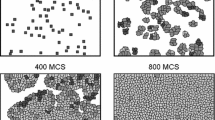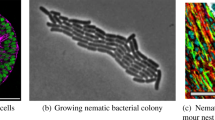Abstract
Growth in biological systems occurs as a consequence of cell proliferation fueled by a nutrient supply. In general, the nutrient gradient of the system will be nonconstant, resulting in biased cell proliferation. We develop a uniaxial discrete cellular automaton with biased cell proliferation using a probability distribution which reflects the nutrient gradient of the system. An explicit probability mass function for the displacement of any tracked cell under the cellular automaton model is derived and verified against averaged simulation results; this displacement distribution has applications in predicting cell trajectories and evolution of expected site occupancies.










Similar content being viewed by others
References
Alber M, Chen N, Glimm T, Lushnikov PM (2006) Multiscale dynamics of biological cells with chemotactic interactions: from a discrete stochastic model to a continuous description. Phys Rev E 73:051901
Baker RE, Yates CA, Erban R (2010) From microscopic to macroscopic descriptions of cell migration on growing domains. Bull Math Biol 72:719–762
Binder BJ, Landman KA (2009) Exclusion processes on a growing domain. J Theor Biol 259:541–551
Binder BJ, Landman KA, Simpson MJ, Mariani M, Newgreen DF (2008) Modeling proliferative tissue growth: a general approach and an avian case study. Phys Rev E 78:031912
Codling EA, Plank MJ, Benhamou S (2008) Random walk models in biology. J R Soc Interface 5(25):813–834
Crampin EJ, Gaffney EA, Maini PK (1999) Reaction and diffusion on growing domains: scenarios for robust pattern formation. Bull Math Biol 61:1093–1120
Crampin EJ, Hackborn WW, Maini PK (2002) Pattern formation in reaction–diffusion models with nonuniform domain growth. Bull Math Biol 64:747–769
Crampin EJ, Maini PK (2001) Modelling biological pattern formation: the role of domain growth. Comments Theor Biol 6:229–249
Deroulers C, Aubert M, Badoual M, Grammaticos B (2009) Modeling tumor cell migration: from microscopic to macroscopic models. Phys Rev E 79:031917
Du H, Ayouz M, Lv P, Perré P (2018) A lattice-based system for modeling fungal mycelial growth in complex environments. Physica A 511:191–206
Goerke U, Chamberlain AHL, Crilly EA, McDonald PJ (2000) Model for water transport into powdered xanthan combining gel swelling and vapor diffusion. Phys Rev E 62:5353
Hywood JD, Hackett-Jones EJ, Landman KA (2013) Modeling biological tissue growth: discrete to continuum representations. Phys Rev E 88:032704
Johnson NL, Kemp AW, Kotz S (2005) Univariate discrete distributions, 3rd edn. Wiley, New Jersey
Kansal AR, Torquato S, Harsh Iv GR, Chiocca EA, Deisboeck TS (2000) Cellular automaton of idealized brain tumor growth dynamics. BioSystems 55:119–127
Kondo S, Asai R (1995) A reaction–diffusion wave on the skin of the marine angelfish Pomacanthus. Nature 376:765–768
Kulesa PM, Cruywagen GC, Lubkin SR, Maini PK, Sneyd J, Ferguson MWJ, Murray JD (1996) On a model mechanism for the spatial patterning of teeth primordia in the alligator. J Theor Biol 180:287–296
Mahmoud H (2008) Pólya urn models. CRC Press, Boca Raton
Osborne JM, Walter A, Kershaw SK, Mirams GR, Fletcher AG, Pathmanathan P, Gavaghan D, Jensen OE, Maini PK, Byrne HM (2010) A hybrid approach to multi-scale modelling of cancer. Philos Trans R Soc A 368:5013–5028
Othmer HG, Stevens A (1997) Aggregation, blowup, and collapse: the abc’s of taxis in reinforced random walks. SIAM J Appl Math 57(1081):1044–1081
Painter KJ (1997) Chemotaxis as a mechanism for morphogenesis. Ph.D. thesis, University of Oxford
Painter KJ (2009) Continuous models for cell migration in tissues and applications to cell sorting via differential chemotaxis. Bull Math Biol 71:1117–1147
Penington CJ, Hughes BD, Landman KA (2011) Building macroscale models from microscale probabilistic models: a general probabilistic approach for nonlinear diffusion and multispecies phenomena. Phys Rev E 84:041120
Pillay S, Byrne HM, Maini PK (2017) Modeling angiogenesis: a discrete to continuum description. Phys Rev E 95:012410
Ross JV, Binder BJ (2014) Approximating spatially exclusive invasion processes. Phys Rev E 89:052709
Ross RJH, Baker RE, Yates CA (2016) How domain growth is implemented determines the long-term behavior of a cell population through its effect on spatial correlations. Phys Rev E 94:012408
Ross RJH, Yates CA, Baker RE (2015) Inference of cell–cell interactions from population density characteristics and cell trajectories on static and growing domains. Math Biosci 264:108–118
Simon BR, Liable JP, Pflaster D, Yuan Y, Krag MH (1996) A poroelastic finite element formulation including transport and swelling in soft tissue structures. J Biomech Eng 118:1–9
Tam A, Green JEF, Balasuriya S, Tek EL, Gardner JM, Sundstrom JF, Jiranek V, Binder BJ (2018) Nutrient-limited growth with non-linear cell diffusion as a mechanism for floral pattern formation in yeast biofilms. J Theor Biol 448:122–141
Tronnolone H, Tam A, Szenczi Z, Green JEF, Balasuriya S, Tek EL, Gardner JM, Sundstrom JF, Jiranek V, Oliver SG, Binder BJ (2018) Diffusion-limited growth of microbial colonies. Sci Rep 8:5992
Turner S, Sherratt JA, Painter KJ, Savill NJ (2004) From a discrete to a continuous model of biological cell movement. Phys Rev E 69:021910
Vulin C, Di Meglio JM, Lindner AB, Daerr A, Murray A, Hersen P (2014) Growing yeast into cylindrical colonies. Biophys J 106:2214–2221
Yates CA (2014) Discrete and continuous models for tissue growth and shrinkage. J Theor Biol 350:37–48
Yates CA, Baker RE, Erban R, Maini PK (2012) Going from microscopic to macroscopic on nonuniform growing domains. Phys Rev E 86:021921
Yates CA, Parker A, Baker RE (2015) Incorporating pushing in exclusion-process models of cell migration. Phys Rev E 91:052711
Acknowledgements
BJB contribution was supported by the Australian Research Council’s Discovery Project DP160102644.
Author information
Authors and Affiliations
Corresponding author
Additional information
Publisher's Note
Springer Nature remains neutral with regard to jurisdictional claims in published maps and institutional affiliations.
Appendix
Appendix
Reformulating the cellular automaton as a time inhomogeneous Markov chain provides an alternative method for calculating the cell displacement distribution numerically. This time inhomogeneous Markov chain is formed by the sequence of random variables \(\{K_n\}_{n\ge 0}\). The transition matrix at some iteration \(n\ge 0\) is given by the \((n+1)\times (n+2)\) matrix
The probability that a fixed agent \(X \in \{1,\dots ,L\}\) is displaced \(k \in \{0,\dots ,N\}\) times in N iterations is then
Rights and permissions
About this article
Cite this article
Lai De Oliveira, A., Binder, B.J. Modeling Uniaxial Nonuniform Cell Proliferation. Bull Math Biol 81, 2220–2238 (2019). https://doi.org/10.1007/s11538-019-00601-4
Received:
Accepted:
Published:
Issue Date:
DOI: https://doi.org/10.1007/s11538-019-00601-4




